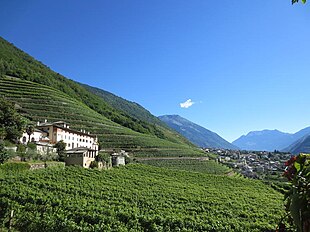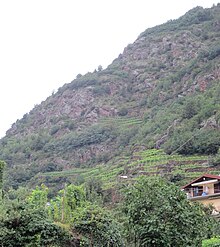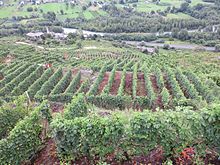Valtellina (wine)
The Valtellina (Swiss: Veltlin ) is a centuries-old wine-growing region in northern Italy in the province of Lombardy on the border with Switzerland and South Tyrol . The Valtellina wine is called Veltliner in Switzerland , but it has no connection with the Austrian white grape variety of the same name.
history
The origins of viticulture in Valtellina go back to pre-Christian times. The decisive impetus for the cultivation of vines came when the region became the dominion of the three leagues from 1550 to 1797 . The Valtellina wine achieved a certain international reputation and the Graubünden trade relations paved the way for it to the courts of Central and Northern Europe. Wine exports to Switzerland still play a major role today.
The total area under cultivation today extends over 995 ha. In the 19th century, the area planted with vines reached its greatest extent, at times over 6000 ha.
Wines
The Valtellina is mainly made from the Nebbiolo grape, which is also called Chiavennasca here. The best known are the Sforzato (or Sfursat) di Valtellina - a straw wine made by drying the grapes - and the Valtellina Superiore, a dry red wine. Both wines have DOCG status. Furthermore, the Rosso di Valtellina DOC and the Terrazze Retiche IGT are produced in the region .
Geographical and climatic conditions for viticulture
The Valtellina is a mountain valley essentially in an east-west direction along the Adda river , from the south side of the Stilfser Joch to Lake Como in the west. The south-facing slopes north of the Adda in the valley section between Tirano and Ardenno are particularly suitable for viticulture .
The valley is bordered by mountain ranges both in the south and in the north, which shield it from cold winds from the north and moist and warm air currents from the south. Lake Como also has a temperature regulating effect. During the vegetation phase (April – October) the temperature is between 5 and 35 degrees. The steep slope of the vineyards (up to 70%) and their perfect south-facing orientation result in strong solar radiation of around 1,900 hours of sunshine per year (for comparison: Freiburg i. Br. 1795 hours of sunshine / year). In addition, the dry stone walls (their length is estimated to be more than 2,500 km) that surround the terraces have a heat-storing and balancing effect. The late-ripening Nebbiolo vines are largely protected from winter frosts and their optimal ripening is possible. The cultivation zone is mainly located at an altitude between 300 and 700 meters above sea level. d. M.
Despite its alpine location, the Valtellina has a temperate climate suitable for viticulture.
As in the Barolo and Barbaresco regions, the Nebbiolo grape also produces long-lasting, expressive and tannin-rich wines here, but the special features of the Valtellina, but above all the comparatively high temperature differences between day and night, create an extremely elegant and fragrant wine .
Growing conditions
Of the 995 ha of vineyards, 915 ha have particular structural difficulties:
- Steep gradient (400 ha with an incline> 30%)
- Terracing through elaborate dry stone walls
- Very small-scale vineyards, terraces with sometimes only a few square meters of usable space
- lack of humus , so that in many cases the required soil has to be moved from the valley to the vineyards.
Another particular difficulty is the extreme fragmentation of the parcels, caused by the inherent fragmentation and inheritance law. 96% of all wine-growing businesses in Valtellina cultivate less than 1 hectare of cultivated land, which often does not exist as a contiguous area. These conditions largely prevent the mechanization of work.
The Italian has found the expression "Viticultura eroica" ( heroic viticulture ) for this form of viticulture .
The Valtellina Superiore
The production area for the Valtellina Superiore DOCG is located in the best locations between the towns of Buglio in Monte and Tirano . This cultivation area also includes the five particularly valued sub-zones ( Sottozone in Italian ) Grumello (78 ha), Inferno (55 ha), Maroggia (25 ha), Sassella (14 ha) and Valgella (137 ha). The production regulations are monitored by the Consorzio di tutela vini Valtellina .
Production guidelines
Valtellina Superiore DOCG
(classified as DOCG since 1998)
- Approved growing area: section of the valley between Buglio in Monte and Tirano in the province of Sondrio
- Grape varieties used Minimum 90% Nebbiolo, 10% unspecified red grape varieties are still permitted
- Minimum alcohol content 12%
- Maximum yield 8000 kg / ha
- Obligatory storage time: 2 years, including 1 year in wooden barrels. (Riserva a total of 3 years storage time)
In order to be allowed to carry the designation of one of the five sub-zones, the grapes must have a higher must weight.
Sforzato di Valtellina DOCG
(classified as DOCG since 2003)
Production rules as for Valtellina Superiore DOCG, but the must is concentrated by drying the grapes, minimum alcohol content 14%
Rosso di Valtellina DOC
The zone, which is approved for the Rosso di Valtellina DOC and the Terrazze Retiche IGT, extends around the core cultivation area of the DOCG wines and into the northern side valleys of the Adda.
- Grape varieties used Minimum 90% Nebbiolo, 10% unspecified red grape varieties are still permitted
- Minimum alcohol content 11%
- Maximum yield 10,000 kg / ha
Terrazze Retiche IGT
The term Terrazze Retiche offers a collecting basin for different wine styles: red / rose / white wines, sparkling wine, sweet wine, Novello.
Web links
Individual evidence
- ↑ a b cervim.org Homepage Cervim
- ↑ a b production regulations. (PDF; Italian)
- ↑ weatheronline.de
- ↑ Consorzio di tutela vini Valtellina ( page no longer available , search in web archives ) Info: The link was automatically marked as defective. Please check the link according to the instructions and then remove this notice.



